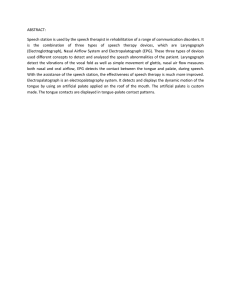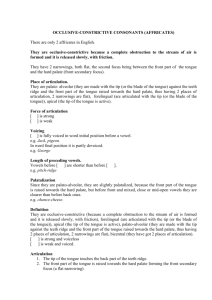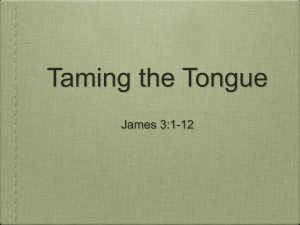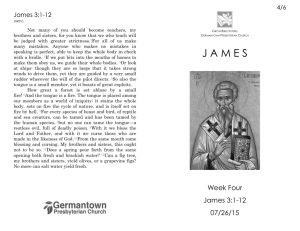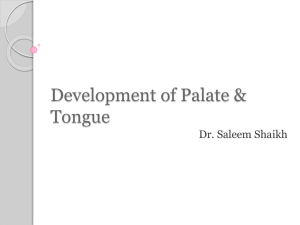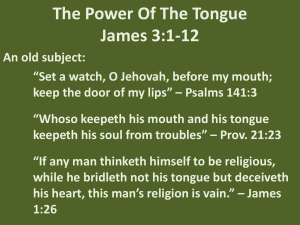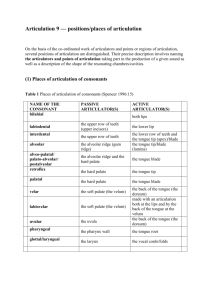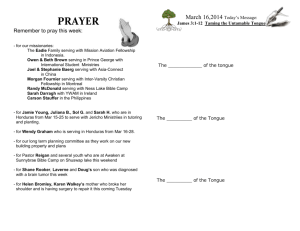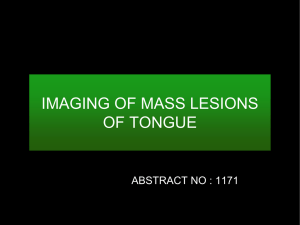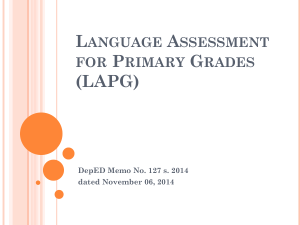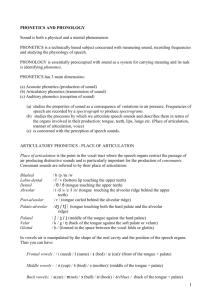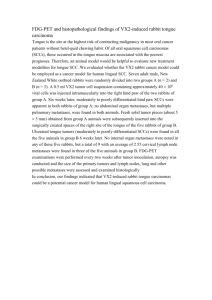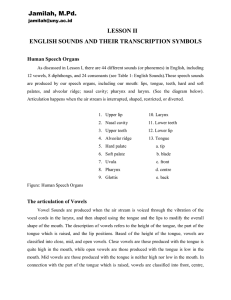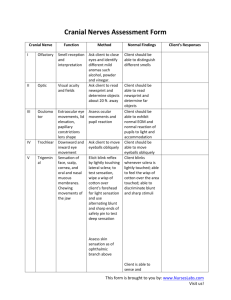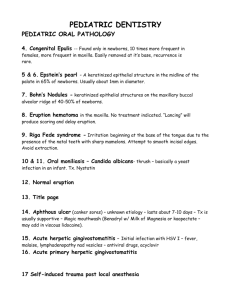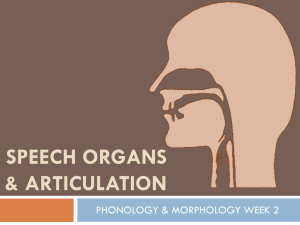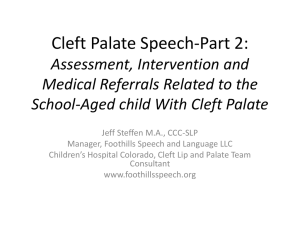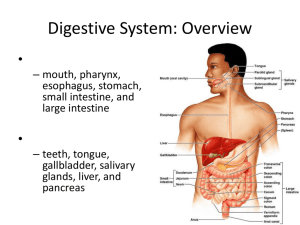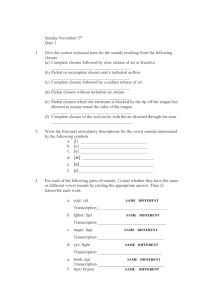Chapter 9 Source-Filter Theory and Problems in Speech Production
advertisement
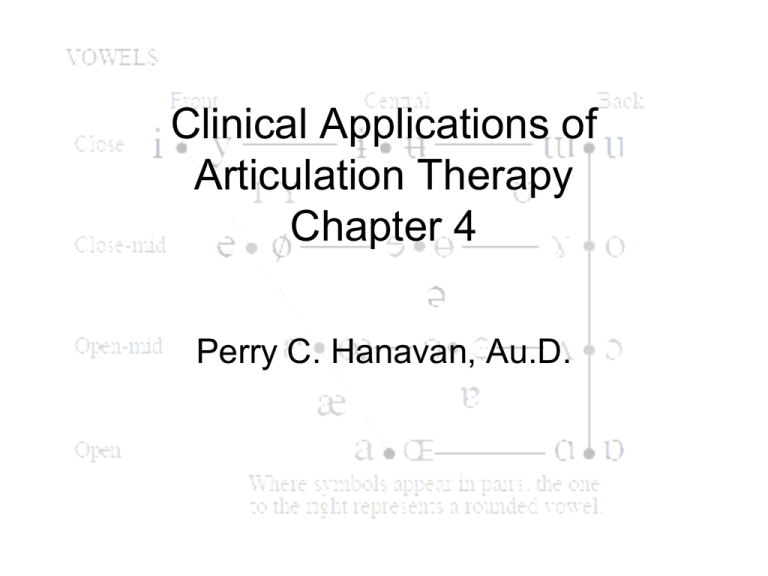
Clinical Applications of Articulation Therapy Chapter 4 Perry C. Hanavan, Au.D. Cineradiography • Ken Stevens x-ray film Strain Gage • The Iowa Oral Performance Instrument (IOPI) is used to objectively measure tongue and lip strength and endurance – Also provides biofeedback for oral motor exercise X-ray Microbeam • Microbeam analyzes speech patterns by tracking small pellets placed on the subject’s tongue, teeth and nose • Tracking accomplished by a very narrow x-ray beam passing through the subject area and detected by a sodium iodide crystal located behind the head • Dense pellets block the x-rays from reaching the crystal • Allows study of speech patterns in real time Ultrasound • Speech therapists are using ultrasound imaging Electropalatography • SmartPalate Oral Devices • Electropalatography • Glossometry • Video with Dr. Samuel Fletcher Palatometry • Device that consists of electrodes mounted on a thin acrylic plate which is custom made to cover the individual’s hard palate and upper teeth and measures tongue and palate contact patterns from electrodes. Glossometry • Device that consists of electrodes mounted on a thin acrylic plate which is custom made to cover the individual’s hard palate and upper teeth and measures optical tracking of tongue surface using LED. MRI • Primarily suitable for static production • Attempted to acquire dynamic MRI image sequences, i.e. MRI "movies" • One technique involves acquisition of single images from an utterance repeated over and over • A new technique for magnetic resonance imaging (MRI) allows movements of joints and organs to be captured in real time Electromagnetic Articulography • See inside patients’ mouths to track their speech movements. • Only about 40 in the world, • Holds out promise as a therapy tool for people who have lost ability to speak. • Small sensors attached to thin wires placed inside mouth with magnified images of mouth movements appearing on screen • helps patients by showing how to position tongue to create speech sounds Source Filter Theory and Problems in Speech Production • Source-filter a way of conceptualizing problems of speech production – Dysarthria—neurologic disorder with weak speech musculature – Hearing loss—difficulty with relationship with acoustic input and speech production – Phonological disorders—often phoneme perceptual problems – Tracheotomy—larynx development, tongue movement – Cleft Palate—velopharyngeal problems (resonance—nasality problems) Dysarthria • Neurological disorders with weak speech production – "Slurred" speech – Speaking softly or barely able to whisper – Slow rate of speech – Rapid speech rate with a "mumbling" quality – Limited tongue, lip, and jaw movement – Abnormal intonation (rhythm) when speaking – Hoarseness, breathiness – Drooling or poor control of saliva – Chewing and swallowing difficulty Sample Vowel Space Slope index • This parameter is measured in Hz per msec, is based on the relationship between the F2 transitions and place of articulation “Deaf Speech” • Individuals with congenital or pre-lingual hearing loss vs. post-lingual loss • Loss of speech intelligibility • Difficulty in segmental aspects of speech • Difficulty in control of suprasegmental aspects of speech • Difficulty co-articulating Segmental Problems • Most frequent errors in spoken language of deaf – Vowel problems (tend to neutralize vowels) – F1/F2/ charts shows marked limitations in both horizontal and vertical degree of tongue movements for vowels – Consonant errors common—omissions and substitutions involving voicing and manner of artic – Place of production errors common because of imprecise tongue position and reduced articulatory movement Acoustic Analysis of Speech • Alveolar and velar stops produced further back in the vocal tract than normal – Provides clues for speech therapy Suprasegmental Aspects • Incorrect Fo in word and sentence production • Not enough variation in Fo to differentiate between declarative vs. interrogative utterances Sample Speech Therapy Emphasis • Some programs put emphasis on speech in education process, others some, and yet others put none • Maasen & Povel (1985) research showed improving segmental production caused 50% improvement in intelligibility with major increase resulting from correcting vowel production Phonological Disorders • Speech disorder known as an articulation disorder. • Do not use some or all of the speech sounds expected for their age group. • Phonological processes – Children use alternative articulation or simpler articulatory gestures in place of the adult model – May produce a /t/ for /k/ sound – Sample Tracheostomy • Surgical procedure to create an opening through the neck into the trachea • Developmental consequences in infants including: – Prevention of larynx from making developmental descent – Thus limiting movement of tongue – Reduction in articulatory movements – Alteration of resonance characteristics – Sample – Sample Cleft Palate • Congenital split in the roof of the mouth. • Resonance issues • High incidence of conductive hearing loss (typically middle ear infections) Sample Sample Sample
